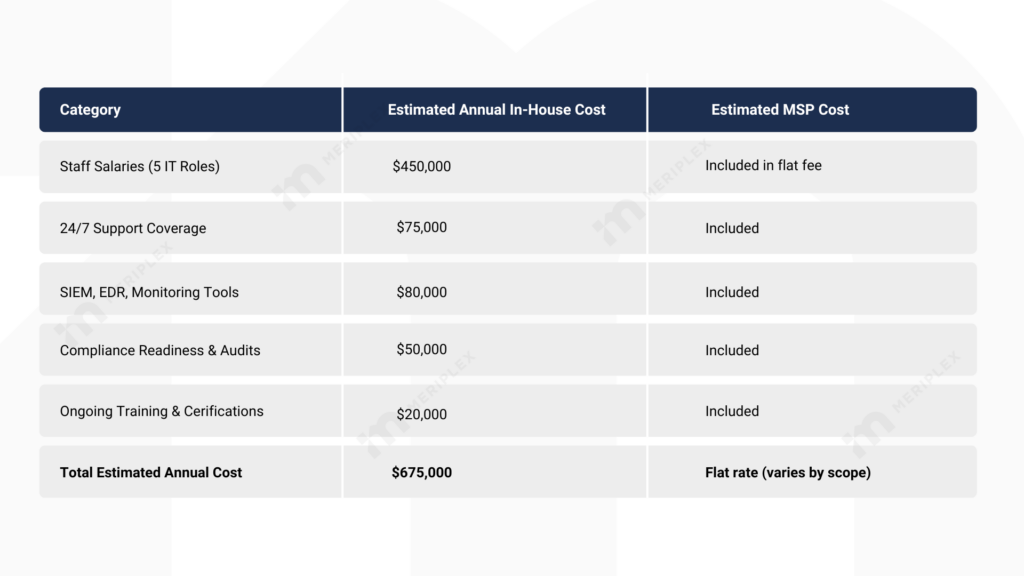Choosing to outsource IT is often the easy part.
When you are in the thick of day-to-day operations, the benefits are obvious. You see the mounting workload, the growing risk surface, the budget strains of staffing and tooling. You know that working with a Managed Services Provider could streamline support, improve security, and free up your internal teams to focus on bigger priorities.
The harder part is convincing everyone else.
For most organizations, the decision to outsource is not made by IT alone. It moves through CFOs, COOs, executive boards, and sometimes even investor groups. Each stakeholder brings different concerns to the table: cost, control, compliance, and business risk.
Building a strong business case is what bridges the gap between technical needs and executive priorities. It shifts the conversation from “should we outsource?” to “how quickly can we get started?”
In this guide, we will walk through what a compelling business case looks like, how to frame outsourcing as a strategic advantage, and what metrics to bring to the table when it is time to have that internal conversation.
1. Understand the Two Forces Driving Outsourcing Conversations Today
When you are building a business case for outsourcing IT, it is easy to default to cost savings as the headline argument. And cost does matter. But the strongest cases recognize that two forces are pushing businesses toward managed services today: cost pressure and risk pressure. Both belong in the conversation.
Cost Pressure: More Tech, Fewer Hands
Internal IT costs are climbing. Skilled professionals are harder to recruit and even harder to retain. Salaries for cybersecurity analysts, cloud engineers, and systems administrators have risen sharply over the last five years, and the infrastructure they manage has only grown more complex.
It is no longer just a matter of maintaining a server room. Today’s IT teams are expected to secure remote users, manage hybrid cloud environments, support SaaS ecosystems, monitor compliance frameworks, and defend against nonstop cyberattacks. All while keeping daily operations running.
Building an in-house team that can cover that breadth of responsibility requires not just salaries, but investments in specialized tools, 24/7 coverage, ongoing training, and scalable infrastructure. For many mid-sized organizations, the math no longer adds up. Outsourcing becomes a strategic way to control operating costs without compromising capability.
Curious What Outsourcing Could Really Save You?
Risk Pressure: More Threats, Tighter Regulations
At the same time, cybersecurity threats are growing faster than most internal teams can keep up. Ransomware, phishing, data breaches, and supply chain attacks are not abstract threats. They are daily realities.
According to the 2023 ConnectWise SMB Cybersecurity Report, 83% of small and mid-sized businesses now say cybersecurity is a top board-level priority. That is not just because attacks are rising. It is because the consequences are getting bigger. Regulatory bodies have tightened compliance standards across industries, and the reputational fallout from a breach can permanently damage trust with customers and partners.
Risk is no longer confined to the IT department. It touches legal, finance, operations, and the brand itself. Executives need to see outsourcing not just as a cost decision, but as a risk management strategy.
Why Both Forces Matter
A business case built only on saving money is vulnerable to being deprioritized when budgets stabilize. A business case that includes risk mitigation, compliance readiness, and operational resilience carries weight at the executive level. It reframes outsourcing as an investment in the business’s stability, reputation, and ability to grow without being sidelined by unseen vulnerabilities.
When you address both cost and risk head-on, you meet leadership where they are—and you build a case that is much harder to ignore.
2. Benchmark the True Cost of In-House IT vs. MSPs
Cost is still part of the conversation. But to make a credible business case, you need more than a vague promise of savings. You need to show the real numbers behind what it takes to staff, equip, and maintain a fully functional IT environment internally—and how outsourcing shifts those costs.
Here is where the math gets practical.
Breaking Down the True Internal IT Cost
Staffing Salaries: An effective IT operation needs more than one generalist. Realistically, it takes a mix of systems administrators, network engineers, cybersecurity analysts, and cloud specialists. Depending on geography, salary costs alone can easily reach into the hundreds of thousands of dollars annually. And that does not account for turnover, recruiting fees, or onboarding new talent when someone leaves.
24/7 Coverage: IT problems do not stick to business hours. Providing true 24/7 support requires either night shifts, weekend coverage, or an on-call rotation that burns out internal teams over time. Holiday coverage adds another layer of cost or complexity.
Infrastructure Spend: Modern IT demands modern tools: SIEM platforms for threat detection, EDR solutions for endpoint protection, monitoring tools for network health, backup and disaster recovery systems, and more. Licensing these platforms individually is expensive—and maintaining them in-house requires continuous patching and management.
Training, Certifications, and Compliance: Staying compliant with frameworks like HIPAA, PCI DSS, CMMC, and the FTC Safeguards Rule is not a one-time project. It requires ongoing training, certifications, policy updates, risk assessments, and often external audits. Internal teams need both time and budget allocated just to keep pace with changing standards.
The Savings Benchmark
According to Deloitte’s Global Outsourcing Survey, companies that outsource IT functions report a 25–45% reduction in operational costs compared to building and maintaining the same capabilities internally.
Those savings do not come from cutting corners. They come from efficiencies of scale. MSPs spread staffing, tools, and monitoring infrastructure across multiple clients, which means you gain access to enterprise-grade services without paying enterprise-sized overhead.
Bonus: Start Estimating Your Own Numbers
If you want to create a simple first-pass cost model for internal discussion, start with this:

These numbers will vary by company size and industry, but they give leadership a realistic sense of how quickly internal costs add up—and why outsourcing shifts the financial model from unpredictable overhead to predictable, scalable service.
3. Frame Outsourcing as a Risk Reduction Strategy, Not Just Cost Savings
If your business case for outsourcing leans only on cost reduction, it will feel optional—especially when budgets tighten and leadership starts scrutinizing every dollar. But when you position outsourcing as risk reduction, the conversation changes.
Executives know that risk costs more than almost anything else: lost revenue during downtime, fines from compliance violations, reputational damage from breaches. And IT risk has only gotten harder to manage internally.
Here’s where outsourcing becomes a strategic advantage.
Faster Incident Detection and Response
One of the biggest vulnerabilities for internal IT teams is lag time. When security alerts come in after hours or on weekends, response windows widen. Threats get a head start.
Most Managed Service Providers (MSPs) offer 24/7 security monitoring with real-time triage and response.
Average MSP response times are under 15 minutes—compared to several hours or even days when companies rely solely on internal staff.
Speed matters. IBM’s 2024 Cost of a Data Breach Report found that organizations with managed security services detect and contain breaches 52% faster than those without.
That is not just a performance metric. It is a direct cost-saver when the average breach costs $4.45 million globally (and even more in regulated industries like healthcare and finance).
Built-In Cybersecurity Expertise
Internal IT teams are often asked to wear every hat: network support, application management, security, compliance, and more. But cybersecurity today is not something you can afford to manage with generalists.
Strong MSPs bring dedicated cybersecurity experts—people trained specifically in threat detection, incident response, vulnerability management, and compliance frameworks. Instead of relying on stretched internal resources, you get access to deep bench strength without the hiring and training lag.
Compliance Without Building an Internal Compliance Department
HIPAA, PCI DSS, CMMC, and the FTC Safeguards Rule all require formal security policies, ongoing monitoring, risk assessments, and incident response protocols.
Building a full compliance-ready IT operation internally takes specialized knowledge, constant updating, and relentless attention to detail.
Partnering with the right MSP gives you direct access to that expertise. Documentation. Reporting. Audit support. Policy management. Instead of scrambling to meet compliance demands reactively, you build compliance-readiness into your everyday operations.
Outsourcing as Proactive Resilience
The companies that treat IT outsourcing as a cost-cutting exercise often fall into a cycle of minimum spend and maximum risk.
The companies that treat IT outsourcing as resilience-building create stability, trust, and operational strength that compounds over time.
Framing your business case around risk mitigation, compliance strength, faster recovery times, and customer trust will resonate with leadership far beyond just financial controllers. It speaks to brand protection, operational continuity, and long-term viability—the things decision-makers are truly hired to safeguard.
Ready to Turn IT Into a Strategic Advantage?
4. Connect Outsourcing to Business Enablement, Not IT Replacement
One of the biggest mental hurdles leaders face when evaluating managed services is fear of “losing control” or “outsourcing core capabilities.”
The reality is different. A strong MSP does not replace your internal IT vision. They make it possible for your internal teams—and your business—to move faster, scale smarter, and innovate without getting dragged down by reactive support.
When you are building your business case, it is important to show outsourcing not as subtraction, but as multiplication.
Faster Scalability Without Growing Internal Overhead
Opening a new location? Onboarding dozens of new remote employees? Migrating to a new cloud platform?
These initiatives strain even the most capable internal IT teams. Without external support, timelines stretch, risks rise, and operational distractions pile up.
With an MSP, you tap into on-demand resources who are ready to scale infrastructure, secure new endpoints, and roll out projects without pulling your core team away from other strategic work. Growth does not have to mean growing internal headcount every time you expand.
More Bandwidth for Innovation (Instead of Constant Firefighting)
In-house IT teams often spend 60% or more of their time on break/fix support, user troubleshooting, patching, and monitoring tasks.
That leaves little room for higher-value initiatives like:
- Cloud strategy
- Security architecture improvements
- Workflow automation
- Application modernization
- Strategic vendor evaluations
An MSP absorbs the heavy operational load—help desk tickets, monitoring, patch management, system backups—so your internal leaders can focus on building an IT environment that supports growth and innovation, not just daily survival.
Executive Peace of Mind: Predictability, Visibility, Control
When IT is managed reactively, costs fluctuate and risks build quietly in the background.
Partnering with an MSP creates a very different experience:
- Predictable spend: Flat-rate billing aligned with your support needs and growth plans.
- Audit-ready documentation: Clear reports on incidents, system health, compliance, and project work.
- No coverage gaps: 24/7 monitoring and support, even during holidays, sick days, or unexpected staff turnover.
For executive teams, this predictability removes an entire category of operational anxiety. Technology becomes a known quantity instead of an unpredictable cost center.
Outsourcing as Acceleration
When you frame MSPs as business enablers—not just technical fixers—you show leadership the real upside:
More agility. More innovation. Less distraction. Less risk.
MSPs are not here to take away your control. They are here to give you the time, stability, and focus to run faster toward your business goals.
5. Prepare for Internal Objections—and How to Address Them
Even when the benefits are clear, proposing an outsourced IT model often brings internal resistance. Some objections come from a place of genuine concern. Others come from fear of change or past bad experiences with vendors who overpromised and underdelivered.
A strong business case does not ignore these objections. It addresses them directly and reframes the conversation around partnership, control, and shared outcomes.
Here are some of the most common objections you may encounter, and how to navigate them:
Objection: “We’ll lose control.”
This is one of the most common fears. Leadership teams worry that outsourcing IT will mean losing visibility into operations, performance, or decision-making authority.
How to reframe: Position the MSP relationship as a partnership, not a handoff. Strong MSPs operate transparently, with clear documentation, regular reporting, defined service level agreements (SLAs), and collaborative planning sessions. Internal leadership remains in control of strategy and decision-making, while the MSP handles execution and support.
Objection: “It will be harder to innovate.”
Some leaders fear that external partners will focus only on maintenance, leaving little room for innovation or modernization efforts.
How to reframe: Show that outsourcing the day-to-day support tasks actually frees up internal IT and leadership teams to focus more energy on innovation. MSPs also bring broad exposure to new technologies and best practices across industries, which can accelerate strategic initiatives rather than slow them down.
Objection: “Security will be weaker.”
There can be a perception that outside vendors will not protect sensitive data or systems as rigorously as internal teams would.
How to reframe: Point to the specialization of strong MSPs. Many bring dedicated cybersecurity teams, 24/7 security monitoring, compliance frameworks like HIPAA or PCI DSS, and faster incident response than internal teams can usually achieve alone. Security is not just maintained; it is often significantly strengthened.
Objection: “Our environment is too complex.”
Leadership might assume that an MSP will not understand the intricacies of your specific applications, workflows, or legacy systems.
How to reframe: Highlight that top-tier MSPs build custom onboarding plans, conduct deep environment discovery, and integrate seamlessly with complex, hybrid infrastructures. Many specialize in managing multi-cloud, multi-location, and legacy-modern hybrid environments. Complexity is not a barrier when expertise and process maturity are in place.
Objections are not roadblocks. They are opportunities to build confidence.
By addressing these concerns early—and framing the relationship as a partnership that enhances control, innovation, and security—you turn resistance into buy-in.
6. How to Structure Your Business Case Document
A well-structured business case is what turns a good idea into a boardroom conversation that gets taken seriously.
It should be clear, data-driven, and directly tied to business outcomes—not just IT improvements.
Here is a simple, high-impact structure you can follow when building your case to outsource IT to a Managed Services Provider (MSP):
Executive Summary: State the Need and the Outcome
Start with a tight overview.
- What is the core issue you are solving?
- Why now?
- What does success look like?
Focus on language that resonates with executives: reduced risk, improved scalability, predictable costs, stronger compliance posture.
Current State Assessment: Paint the Real Picture
Lay out your current reality in straightforward terms:
- What are the pain points with internal IT today?
- Where are you seeing inefficiencies, risk exposure, or capability gaps?
- What are the current costs, including staffing, tools, downtime, and compliance-related efforts?
This creates urgency and frames outsourcing as a solution to a real, measurable problem.
Proposed Model: Define the Scope and the Outcomes
Detail what outsourcing will look like:
- Scope of services you would outsource (help desk, monitoring, cybersecurity, compliance support)
- What internal teams will retain control of
- How support and escalation will work
- What systems or processes will improve immediately
This section should leave no ambiguity about who is doing what.
Projected ROI: Connect Dollars and Risk Reduction
Move beyond “cost savings” alone.
Show the full ROI by connecting outsourcing to:
- Reduction in operational costs
- Faster incident response times
- Improved compliance posture
- Decreased downtime risks
- More internal bandwidth for innovation
Use real benchmarks when possible, like Deloitte’s finding that outsourcing IT can reduce operational costs by 25 to 45 percent.
Implementation Plan: Map the Transition
Executives are naturally risk-averse about change.
Include a simple timeline with key phases:
- Discovery and environment assessment
- Transition period with parallel support
- Full handover with checkpoints and executive reporting
- Metrics for success at 30, 60, and 90 days
Show that outsourcing will be structured, gradual, and measured.
Appendix: Arm Yourself with Proof Points
End with supporting material that reinforces your case:
- Industry benchmarks on cost savings and security improvements
- Compliance benefits tied to specific regulations your company must meet
- Case studies of similar companies who successfully transitioned to an MSP model
If you can show success stories in your industry or region, even better.
The best business cases are not just technically correct.
They are emotionally intelligent, anticipating concerns, emphasizing strategic growth, and making it easy for leadership to say yes.
Build the Business Case with Real Numbers
Conclusion: Outsourcing IT Is a Growth Decision, Not a Cost Decision
Outsourcing IT is often framed as a way to cut costs, but that misses the real opportunity.
This is not about doing more with less. It is about doing more with better. It is about building a technology foundation that scales with you, protects your business from avoidable risks, and frees up your teams to focus on innovation, not just maintenance.
When you partner with the right Managed Services Provider, you are not giving up control. You are building resilience. You are creating space for internal teams to drive bigger initiatives, while specialists handle the operational complexity that can slow businesses down.
The strongest companies are the ones that recognize when it is time to shift gears.
Outsourcing IT is not just a support decision. It is a strategic growth decision—and the businesses that act on it early are the ones that move faster, stay safer, and build stronger futures.



